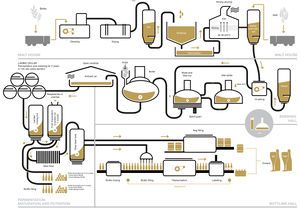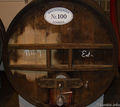Brouwerij Boon: Difference between revisions
No edit summary |
m →History |
||
| (37 intermediate revisions by 7 users not shown) | |||
| Line 1: | Line 1: | ||
[[File:Brouwerij | [[File:Brouwerij Logo 2020 ZWART Tekengebied 1.png|right|300px]] | ||
'''Website (English):''' | '''Website (English):''' http://www.boon.be/ | ||
'''Instagram''' @brouwerij_boon | |||
'''Facebook''' https://www.facebook.com/BrouwerijBoon? | |||
'''Phone:''' +32 (0)23 56 66 44 | '''Phone:''' +32 (0)23 56 66 44 | ||
'''Address:''' Fonteinstraat 65 | '''Address:''' Fonteinstraat 65, 1502 Lembeek | ||
== Overview == | == Overview == | ||
Brouwerij Boon is a lambic brewery located in Lembeek. Boon produces a wide range of | Brouwerij Boon is a lambic brewery located in Lembeek. Boon produces a wide range of lambics, including oude geuze, oude kriek, a sweetened kriek, faro, and several other lambics under different names of former lambic breweries including Moriau and Dekoninck. In addition to bottling its own lambic, Boon also provides wort, fruit, and facility use to several lambic brewers and blenders. | ||
== History == | == History == | ||
Though the strand that connects Brouwerij Boon to the brewing world dates back to the 17th century, the modern history of Brouwerij Boon as a lambic producer starts around | Though the strand that connects Brouwerij Boon to the brewing world dates back to the 17th century, the modern history of Brouwerij Boon as a lambic producer starts around 1975, when founder and father of current owners Frank Boon started receiving deliveries of De Vits lambic for a local youth club to which he belonged and where he began experimenting (in the cellar of a bar he was working at on the weekend during his military service) with creating faro and blending the various lambics into geuze. In 1978, he purchased the [[Brasserie R. De Vits | De Vits brewery]] (the brewing activities had stopped and only the blending side of the operations was still happening, by that time Rene De Vits and his sister Jeanne decided to retire).<ref name=LambicLand>Tim Webb, Chris Pollard, Siobhan McGinn, [[Books#LambicLand: A Journey Round the Most Unusual Beers in the World|LambicLand: A Journey Round the Most Unusual Beers in the World]], 2010</ref><ref name=GeuzeKriek>Jef Van den Steen, [[Books#Geuze & Kriek: The Secret of Lambic Beer|Geuze & Kriek: The Secret of Lambic Beer]], 2012</ref> . After taking over the De Vits location, Boon moved the business from Halle to the Hondzocht district of Lembeek.<ref name=GeuzeKriek>Jef Van den Steen, [[Books#Geuze & Kriek: The Secret of Lambic Beer|Geuze & Kriek: The Secret of Lambic Beer]], 2012</ref> | ||
In order to continue blending lambics, Frank Boon also became a beer distributor for local brands. By | In order to continue blending lambics and fund his project, Frank Boon also became a beer distributor for local brands, becoming the first in Belgium to offer an assortment of regional specialty beers. By 1982, Boon purchased a bankrupted factory in the center of Lembeek and moved the distributorship onto the site, leaving more room for the blending business at the Hondzocht location. By 1986, the site in the center of Lembeek had become home to an automatic bottling plant, a boiling kettle, and a bottle cellar. It is still owned to this day. | ||
[[File:BoonSign2.jpg|left|thumb|Sign to Boon]] | [[File:BoonSign2.jpg|left|thumb|Sign to Boon]] | ||
In 1988, Frank Boon purchased a mash tun and kettle from the Rubbens brewery and a second kettle from the Lemaire brewery, thus completing the original Boon brewhouse. The new brewing setup initially acted as a pilot brewery for Brouwerij De Gouden Boom (owned by Frank Boon and Paul Vanneste since 1983) However, to avoid excise tax issues, the first batch of Boon lambic was brewed in | In 1988, Frank Boon purchased a mash tun and kettle from the Rubbens brewery and a second kettle from the Lemaire brewery, thus completing the original Boon brewhouse which he finished assembling by 1990 (with the addition of a stainless steel coolship, the only brand new piece of equipment). The new brewing setup initially acted as a pilot brewery for Brouwerij De Gouden Boom (owned by Frank Boon and Paul Vanneste since 1983). However, to avoid excise tax issues, the first batch of Boon lambic was brewed in september 1990.<ref name=GeuzeKriek>Jef Van den Steen, [[Books#Geuze & Kriek: The Secret of Lambic Beer|Geuze & Kriek: The Secret of Lambic Beer]], 2012</ref><ref name=HoralBoon>Horal - Boon (Dutch), http://www.horal.be/vereniging/boon-lembeek</ref> | ||
Frank Boon eventually left the distribution business due to losing exclusive rights on many of the local beers. To distribute his new lambic, Boon initially signed a deal with the Belgian wine and spirits distributor Fourcroy. The deal, which resulted in Fourcroy buying a 50% share in the new brewery, did not produce the results that Frank had hoped for. Eventually, Boon was able to buy back all of the shares of the brewery. In 1994 he also sold his stake in the De Gouden Boom brewery, which would also become part of the Palm Brewing group in 2003.<ref name=PalmDeGoudenBoom>Palm Brewery - De Gouden Boom (Dutch), http://www.palm.be/nl/degoudenboom</ref> Around the same time, Frank Boon resold a 50% stake in the Boon brewery to the Palm Brewing group | Frank Boon eventually left the distribution business in 1986 due to losing exclusive rights on many of the local beers and other companies using the same model. To distribute his new lambic, Boon initially signed a deal with the Belgian wine and spirits distributor Fourcroy. The deal, which resulted in Fourcroy buying a 50% share in the new brewery, did not produce the results that Frank had hoped for, especially in the context of the late 80's where the brewery was close to bankruptcy. Eventually, Boon was able to buy back all of the shares of the brewery. In 1994, he also sold his stake in the De Gouden Boom brewery, which would also become part of the Palm Brewing group in 2003.<ref name=PalmDeGoudenBoom>Palm Brewery - De Gouden Boom (Dutch), http://www.palm.be/nl/degoudenboom</ref> Around the same time, Frank Boon resold a 50% stake in the Boon brewery to the Palm Brewing group, and in 2014, these shares were transferred to Diepensteyn Holding. | ||
It was said that Frank Boon had acquired the name rights to many old lambic breweries and blenders, including Moriau, Dekoninck, and Vandervelden<ref name=LambicLand>Tim Webb, Chris Pollard, Siobhan McGinn, [[Books#LambicLand: A Journey Round the Most Unusual Beers in the World|LambicLand: A Journey Round the Most Unusual Beers in the World]], 2010</ref>, but it was denied by his son Karel, though Boon continues to produce beer for Moriau and Dekoninck. In 2011, Boon bought an entirely new one-of-its-kind brewhouse with tanks designed specifically for lambic, which took two years to build, before seeing a first test brew in october 2013 (with Frank's son Jos who joined the brewery as a bio engineer the previous year while finishing his studies - his brother Karel joined as well in 2017, taking care of the business and marketing side of things).<ref name=LambicLand>Tim Webb, Chris Pollard, Siobhan McGinn, [[Books#LambicLand: A Journey Round the Most Unusual Beers in the World|LambicLand: A Journey Round the Most Unusual Beers in the World]], 2010</ref><ref name=GeuzeKriek>Jef Van den Steen, [[Books#Geuze & Kriek: The Secret of Lambic Beer|Geuze & Kriek: The Secret of Lambic Beer]], 2012</ref><ref name=BoonInterview2025>Lambic.info interview with Karel Boon, august 2025</ref> | |||
[[File:BrouwerijBoon-1.jpg|thumb|right|Boon's brewhouse]] | [[File:BrouwerijBoon-1.jpg|thumb|right|Boon's brewhouse]] | ||
The | The Monoblend series was launched the same year to celebrate this new chapter of the brewery (with a first blend bottled in 2010 kept asidefor the occasion). | ||
Frank Boon has also been instrumental in keeping the [[Brouwerij_Oud_Beersel|Oud Beersel]] brewery alive. Boon had previously supplied the brewery with malt and hops. In 1996, the bottling line (still in use from 1938) at the Oud Beersel failed and Boon began bottling for them. Starting in 1997, Boon supplied cherries to Oud Beersel for the kriek, and when | In 2014 they added an in-house cooperage workshop to work on their own barrels (the work has always been done on site but without a dedicated space which allowed them to add equipment), it runs for about 10 to 15 weeks per year in average. In 2016, they expended with a 4th warehouse hosting 40 Foeders of about 25,000L each. As the Foeders were kept dry for decades, it took an effort of about a hundred days to get them back on their feet soaking the wood in water so they would stop leaking. | ||
The importance of Brouwerij Boon and Frank Boon in the lambic community in Belgium cannot be understated. The size of Boon’s infrastructure means that Frank has been able to help smaller lambic brewers and blenders in many ways. Boon used to source approximately 180,000-190,000 kg of cherries per year from Galicia (nowadays about 300,000kg), a region that spans the border between Poland and Ukraine. Some of these cherries go to other brewers and blenders. Boon also sources approximately 28,000 kg of raspberries from the same area.<ref name=Summit12>Frank Boon, 2010, [[The_Lambic_Summit_2010#Part_12|The Lambic Summit, Part 12 (Shelton Brothers)]]</ref> In addition to providing other lambic brewers and blenders with fruit, Boon has also bottled for 3 Fonteinen, Oud Beersel, and [[Brasserie_Mort_Subite|Mort Subite]].<ref name=GeuzeKriek>Jef Van den Steen, [[Books#Geuze & Kriek: The Secret of Lambic Beer|Geuze & Kriek: The Secret of Lambic Beer]], 2012</ref> Boon lambic is also a principle component in many gueuze blends, including Tilquin's, Hanssens', Oud Beersel and Boerenerf (as well as 3 Fonteinen until 2018). | |||
Frank Boon has also been instrumental in keeping the [[Brouwerij_Oud_Beersel|Oud Beersel]] brewery alive. Boon had previously supplied the brewery with malt and hops. In 1996, the bottling line (still in use from 1938) at the Oud Beersel failed and Boon began bottling for them. Starting in 1997, Boon supplied cherries to Oud Beersel for the kriek, and when Oud Beersel closed in 2002, Boon bought the remaining stock and sold it under the Oud Beersel name. By 2005, Oud Beersel had reopened with lambic brewed at Boon, using an old Vandervelden recipe. [[File:BrouwerijBoon-3.jpg|left|thumb|Boon crates]] Today, Oud Beersel lambic is still brewed at Boon, barreled at Oud Beersel, and blended with other lambics, including Boon.<ref name=BoonOudBeersel>Frank Boon, 2004, [http://www.babblebelt.com/bbb_classic/readarc.html?id=1098553776#null|Re: Boon's involvement in Oud Beersel...how long?]</ref> Boon, along with ten other brewers and blenders make up [[HORAL]]. | |||
<ref name=HoralBoon>Horal - Boon (Dutch), http://www.horal.be/vereniging/boon-lembeek</ref> | |||
In 2021, Frank retired, while Karel and Jos Boon took over the 50% ownership of Diepsteyn Holdings, making the brewery 100% family owned again, shared equally between the both of them. That same year the brewery launched the Sustainable Oak Initiative, sourcing ten logs of 250 years old Belgian oak from a forest located south of Leuven, which should last for about 200 years, in order to fix and maintain their own barrels on the long term. | |||
2025 sees the 50th anniversary of the brewery and two limited edition beers were made for the occasion, the first one in collaboration with Colruyt (Oude Geuze Boon Special Boon & Colruyt Family Blend ) has already been releases, while the second one will see a release later this year. The brewery will also organize and be part of several events to celebrate these 50 years. | |||
==Brewing Process== | ==Brewing Process== | ||
| Line 37: | Line 46: | ||
* 40% of the starch is from unmalted wheat | * 40% of the starch is from unmalted wheat | ||
* The lambic has an acidity | * The lambic has an acidity from pH 3.2-3.6 | ||
* Lambic carbon dioxide content is between 0.5 | * Lambic carbon dioxide content is between 0.5-2.0 g CO₂/L | ||
* Geuze carbon dioxide content is | * Geuze carbon dioxide content is approximately 8 g CO₂/L | ||
* Boon lambic uses real fruit such as cherries and raspberries as opposed to juices, extracts, or flavorings<ref name=PalmBoon>Brouwerij Boon, Brewing Process http://palmbreweries.com/en/boon</ref> | * Boon lambic uses real fruit such as cherries and raspberries as opposed to juices, extracts, or flavorings <ref name=PalmBoon>Brouwerij Boon, Brewing Process http://palmbreweries.com/en/boon</ref> | ||
* Boon has its own Cherry Orchard where many cherry varieties are grown and tested.<ref name=BoonOrchard>Brouwerij Boon, Cherry Orchard http://www.boon.be/en/cherry-grove</ref> However a majority of Boon's cherries and raspberries are hand-picked in the Galicia region of Poland.<ref name=LambicSummit13>[[The Lambic Summit 2010#Part 13|The Lambic Summit 2010, Part 13]]</ref> | * Boon has its own Cherry Orchard where many cherry varieties are grown and tested.<ref name=BoonOrchard>Brouwerij Boon, Cherry Orchard http://www.boon.be/en/cherry-grove</ref> However, a majority of Boon's cherries and raspberries are hand-picked in the Galicia region of Poland.<ref name=LambicSummit13>[[The Lambic Summit 2010#Part 13|The Lambic Summit 2010, Part 13]]</ref> | ||
* Under a Belgian law as amended in 1993, geuze must be made based on spontaneous fermentation only, without specifying what percentage of spontaneous-fermentation beer must be present. Hence, geuze beers and their fruit varieties that are not prefixed with “oude” are not produced by spontaneous fermentation alone, or in some cases only to a very limited extent.<ref name=PalmBoon>Boon | * Under a Belgian law as amended in 1993, geuze must be made based on spontaneous fermentation only, without specifying what percentage of spontaneous-fermentation beer must be present. Hence, geuze beers and their fruit varieties that are not prefixed with “oude” are not produced by spontaneous fermentation alone, or in some cases only to a very limited extent. <ref name=PalmBoon>Brouwerij Boon, Brewing Process http://palmbreweries.com/en/boon</ref> | ||
* The beer is stored primarily in large wooden barrels, called foeders. Brouwerij Boon has a park of more than 100 horizontal casks averaging 8,000 | * The beer is stored primarily in large wooden barrels, called foeders. Brouwerij Boon has a park of more than 100 horizontal casks averaging 8,000 L capacity each. Only old oak barrels are used, as new oak contains too many tannins''<ref name=BoonFoeders>Brouwerij Boon, Best By Dates http://www.boon.be/en/casks-lambic/casks </ref> | ||
* When Boon's beers are bottled, they are marked with a best by date that is 20 years after the bottling date.<ref name=BoonGueuze>Brouwerij Boon, Best By Dates http://www.boon.be/en/our-beers/geuze-boon-old-style </ref> | * When Boon's beers are bottled, they are marked with a best by date that is 20 years after the bottling date.<ref name=BoonGueuze>Brouwerij Boon, Best By Dates http://www.boon.be/en/our-beers/geuze-boon-old-style </ref> | ||
| Line 61: | Line 70: | ||
== Beers == | == Beers == | ||
=== Geuze === | === Geuze === | ||
* [[Boon/Mikkeller Cuvée Oude Henri|Boon/Mikkeller Cuvée Oude Henri]] | |||
* [[Boon/Mikkeller Goût Américain|Boon/Mikkeller Goût Américain]] | |||
* [[Boon/Mikkeller Oude Geuze Boon Bone Dry]] | |||
* [[Boon/Mikkeller Oude Geuze (Calvados Aged)|Boon/Mikkeller Oude Geuze (Calvados Aged)]] | |||
* [[Boon/Mikkeller Oude Geuze (White Vermouth Aged)|Boon/Mikkeller Oude Geuze (White Vermouth Aged)]] | |||
* [[Cuvée Lambikstoemper, De Lambikstoempers 15th Anniversary Oude Geuze]] | * [[Cuvée Lambikstoemper, De Lambikstoempers 15th Anniversary Oude Geuze]] | ||
* [[Moriau Geuze]] | * [[Moriau Geuze]] | ||
* [[Oude Geuze Apogee]] | |||
* [[Oude Geuze Boon]] | * [[Oude Geuze Boon]] | ||
* [[Oude Geuze Boon Black Label]] | |||
* [[Oude Geuze Boon Special Boon & Colruyt Family Blend]] | |||
* [[Oude Geuze Mariage Parfait]] | * [[Oude Geuze Mariage Parfait]] | ||
* [[Vat 31 Monoblend]] | |||
* [[Vat 44 Monoblend]] | * [[Vat 44 Monoblend]] | ||
* [[Vat 77 Monoblend]] | * [[Vat 77 Monoblend]] | ||
* [[Vat 79 Monoblend]] | |||
* [[Vat 86 Monoblend]] | |||
* [[Vat 91 Monoblend]] | |||
* [[Vat 92 Monoblend]] | |||
* [[Vat 108 Monoblend]] | |||
* [[Vat 108 bis Monoblend]] | |||
* [[Vat 109 Monoblend]] | |||
* [[Vat 110 Monoblend]] | |||
=== Faro === | === Faro === | ||
| Line 76: | Line 102: | ||
* [[Framboise Boon|Framboise Boon]] | * [[Framboise Boon|Framboise Boon]] | ||
* [[Frambozenlambik Boon|Frambozenlambik Boon]] | * [[Frambozenlambik Boon|Frambozenlambik Boon]] | ||
* [[Kali Babou]] | |||
* [[Kriek Boon]] | * [[Kriek Boon]] | ||
* [[Kriekenlambik Boon]] | * [[Kriekenlambik Boon]] | ||
Latest revision as of 12:18, 9 August 2025

Website (English): http://www.boon.be/
Instagram @brouwerij_boon
Facebook https://www.facebook.com/BrouwerijBoon?
Phone: +32 (0)23 56 66 44
Address: Fonteinstraat 65, 1502 Lembeek
Overview
Brouwerij Boon is a lambic brewery located in Lembeek. Boon produces a wide range of lambics, including oude geuze, oude kriek, a sweetened kriek, faro, and several other lambics under different names of former lambic breweries including Moriau and Dekoninck. In addition to bottling its own lambic, Boon also provides wort, fruit, and facility use to several lambic brewers and blenders.
History
Though the strand that connects Brouwerij Boon to the brewing world dates back to the 17th century, the modern history of Brouwerij Boon as a lambic producer starts around 1975, when founder and father of current owners Frank Boon started receiving deliveries of De Vits lambic for a local youth club to which he belonged and where he began experimenting (in the cellar of a bar he was working at on the weekend during his military service) with creating faro and blending the various lambics into geuze. In 1978, he purchased the De Vits brewery (the brewing activities had stopped and only the blending side of the operations was still happening, by that time Rene De Vits and his sister Jeanne decided to retire).[1][2] . After taking over the De Vits location, Boon moved the business from Halle to the Hondzocht district of Lembeek.[2]
In order to continue blending lambics and fund his project, Frank Boon also became a beer distributor for local brands, becoming the first in Belgium to offer an assortment of regional specialty beers. By 1982, Boon purchased a bankrupted factory in the center of Lembeek and moved the distributorship onto the site, leaving more room for the blending business at the Hondzocht location. By 1986, the site in the center of Lembeek had become home to an automatic bottling plant, a boiling kettle, and a bottle cellar. It is still owned to this day.
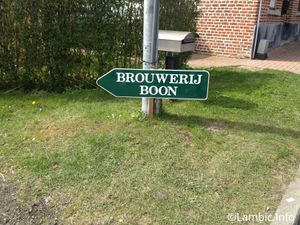
In 1988, Frank Boon purchased a mash tun and kettle from the Rubbens brewery and a second kettle from the Lemaire brewery, thus completing the original Boon brewhouse which he finished assembling by 1990 (with the addition of a stainless steel coolship, the only brand new piece of equipment). The new brewing setup initially acted as a pilot brewery for Brouwerij De Gouden Boom (owned by Frank Boon and Paul Vanneste since 1983). However, to avoid excise tax issues, the first batch of Boon lambic was brewed in september 1990.[2][3]
Frank Boon eventually left the distribution business in 1986 due to losing exclusive rights on many of the local beers and other companies using the same model. To distribute his new lambic, Boon initially signed a deal with the Belgian wine and spirits distributor Fourcroy. The deal, which resulted in Fourcroy buying a 50% share in the new brewery, did not produce the results that Frank had hoped for, especially in the context of the late 80's where the brewery was close to bankruptcy. Eventually, Boon was able to buy back all of the shares of the brewery. In 1994, he also sold his stake in the De Gouden Boom brewery, which would also become part of the Palm Brewing group in 2003.[4] Around the same time, Frank Boon resold a 50% stake in the Boon brewery to the Palm Brewing group, and in 2014, these shares were transferred to Diepensteyn Holding.
It was said that Frank Boon had acquired the name rights to many old lambic breweries and blenders, including Moriau, Dekoninck, and Vandervelden[1], but it was denied by his son Karel, though Boon continues to produce beer for Moriau and Dekoninck. In 2011, Boon bought an entirely new one-of-its-kind brewhouse with tanks designed specifically for lambic, which took two years to build, before seeing a first test brew in october 2013 (with Frank's son Jos who joined the brewery as a bio engineer the previous year while finishing his studies - his brother Karel joined as well in 2017, taking care of the business and marketing side of things).[1][2][5]
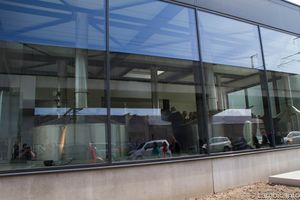
The Monoblend series was launched the same year to celebrate this new chapter of the brewery (with a first blend bottled in 2010 kept asidefor the occasion).
In 2014 they added an in-house cooperage workshop to work on their own barrels (the work has always been done on site but without a dedicated space which allowed them to add equipment), it runs for about 10 to 15 weeks per year in average. In 2016, they expended with a 4th warehouse hosting 40 Foeders of about 25,000L each. As the Foeders were kept dry for decades, it took an effort of about a hundred days to get them back on their feet soaking the wood in water so they would stop leaking.
The importance of Brouwerij Boon and Frank Boon in the lambic community in Belgium cannot be understated. The size of Boon’s infrastructure means that Frank has been able to help smaller lambic brewers and blenders in many ways. Boon used to source approximately 180,000-190,000 kg of cherries per year from Galicia (nowadays about 300,000kg), a region that spans the border between Poland and Ukraine. Some of these cherries go to other brewers and blenders. Boon also sources approximately 28,000 kg of raspberries from the same area.[6] In addition to providing other lambic brewers and blenders with fruit, Boon has also bottled for 3 Fonteinen, Oud Beersel, and Mort Subite.[2] Boon lambic is also a principle component in many gueuze blends, including Tilquin's, Hanssens', Oud Beersel and Boerenerf (as well as 3 Fonteinen until 2018).
Frank Boon has also been instrumental in keeping the Oud Beersel brewery alive. Boon had previously supplied the brewery with malt and hops. In 1996, the bottling line (still in use from 1938) at the Oud Beersel failed and Boon began bottling for them. Starting in 1997, Boon supplied cherries to Oud Beersel for the kriek, and when Oud Beersel closed in 2002, Boon bought the remaining stock and sold it under the Oud Beersel name. By 2005, Oud Beersel had reopened with lambic brewed at Boon, using an old Vandervelden recipe.
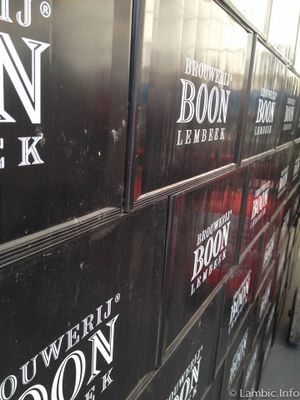
Today, Oud Beersel lambic is still brewed at Boon, barreled at Oud Beersel, and blended with other lambics, including Boon.[7] Boon, along with ten other brewers and blenders make up HORAL.
In 2021, Frank retired, while Karel and Jos Boon took over the 50% ownership of Diepsteyn Holdings, making the brewery 100% family owned again, shared equally between the both of them. That same year the brewery launched the Sustainable Oak Initiative, sourcing ten logs of 250 years old Belgian oak from a forest located south of Leuven, which should last for about 200 years, in order to fix and maintain their own barrels on the long term.
2025 sees the 50th anniversary of the brewery and two limited edition beers were made for the occasion, the first one in collaboration with Colruyt (Oude Geuze Boon Special Boon & Colruyt Family Blend ) has already been releases, while the second one will see a release later this year. The brewery will also organize and be part of several events to celebrate these 50 years.
Brewing Process
The Palm website describes Boon's brewing process as in line with traditional lambic brewing processes, though it notes the following additional specific details about Boon's processes:
- The brewing water has a rather high mineral content
- 40% of the starch is from unmalted wheat
- The lambic has an acidity from pH 3.2-3.6
- Lambic carbon dioxide content is between 0.5-2.0 g CO₂/L
- Geuze carbon dioxide content is approximately 8 g CO₂/L
- Boon lambic uses real fruit such as cherries and raspberries as opposed to juices, extracts, or flavorings [8]
- Boon has its own Cherry Orchard where many cherry varieties are grown and tested.[9] However, a majority of Boon's cherries and raspberries are hand-picked in the Galicia region of Poland.[10]
- Under a Belgian law as amended in 1993, geuze must be made based on spontaneous fermentation only, without specifying what percentage of spontaneous-fermentation beer must be present. Hence, geuze beers and their fruit varieties that are not prefixed with “oude” are not produced by spontaneous fermentation alone, or in some cases only to a very limited extent. [8]
- The beer is stored primarily in large wooden barrels, called foeders. Brouwerij Boon has a park of more than 100 horizontal casks averaging 8,000 L capacity each. Only old oak barrels are used, as new oak contains too many tannins[11]
- When Boon's beers are bottled, they are marked with a best by date that is 20 years after the bottling date.[12]
- For Boon's non-traditional lambic products, Boon reportedly spontaneously ferments approximately 40% of the wort and then blends it back in with the remaining wort.citation needed
Palm's website also includes the following downloadable diagram detailing the process as lambic moves through the Boon brewery.[13]
Beers
Geuze
- Boon/Mikkeller Cuvée Oude Henri
- Boon/Mikkeller Goût Américain
- Boon/Mikkeller Oude Geuze Boon Bone Dry
- Boon/Mikkeller Oude Geuze (Calvados Aged)
- Boon/Mikkeller Oude Geuze (White Vermouth Aged)
- Cuvée Lambikstoemper, De Lambikstoempers 15th Anniversary Oude Geuze
- Moriau Geuze
- Oude Geuze Apogee
- Oude Geuze Boon
- Oude Geuze Boon Black Label
- Oude Geuze Boon Special Boon & Colruyt Family Blend
- Oude Geuze Mariage Parfait
- Vat 31 Monoblend
- Vat 44 Monoblend
- Vat 77 Monoblend
- Vat 79 Monoblend
- Vat 86 Monoblend
- Vat 91 Monoblend
- Vat 92 Monoblend
- Vat 108 Monoblend
- Vat 108 bis Monoblend
- Vat 109 Monoblend
- Vat 110 Monoblend
Faro
Fruit
- Framboise Boon
- Frambozenlambik Boon
- Kali Babou
- Kriek Boon
- Kriekenlambik Boon
- Moriau Kriek
- Oude Kriek Mariage Parfait
- Oude Kriek Boon
Oude Lambiek
Jonge Lambiek
Unclassified
Breweriana
Photos
Videos
References
- ↑ Jump up to: 1.0 1.1 1.2 Tim Webb, Chris Pollard, Siobhan McGinn, LambicLand: A Journey Round the Most Unusual Beers in the World, 2010
- ↑ Jump up to: 2.0 2.1 2.2 2.3 2.4 Jef Van den Steen, Geuze & Kriek: The Secret of Lambic Beer, 2012
- ↑ Jump up to: 3.0 3.1 Horal - Boon (Dutch), http://www.horal.be/vereniging/boon-lembeek
- ↑ Palm Brewery - De Gouden Boom (Dutch), http://www.palm.be/nl/degoudenboom
- ↑ Lambic.info interview with Karel Boon, august 2025
- ↑ Frank Boon, 2010, The Lambic Summit, Part 12 (Shelton Brothers)
- ↑ Frank Boon, 2004, Boon's involvement in Oud Beersel...how long?
- ↑ Jump up to: 8.0 8.1 Brouwerij Boon, Brewing Process http://palmbreweries.com/en/boon
- ↑ Brouwerij Boon, Cherry Orchard http://www.boon.be/en/cherry-grove
- ↑ The Lambic Summit 2010, Part 13
- ↑ Brouwerij Boon, Best By Dates http://www.boon.be/en/casks-lambic/casks
- ↑ Brouwerij Boon, Best By Dates http://www.boon.be/en/our-beers/geuze-boon-old-style
- ↑ Brouwerij Boon, Brewing Process Diagram http://newpalm.androidlabs.be/uploads/boon/brouwschema_spontanegisting_EN.jpg
